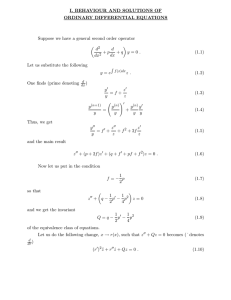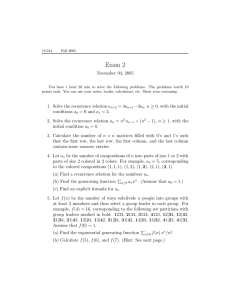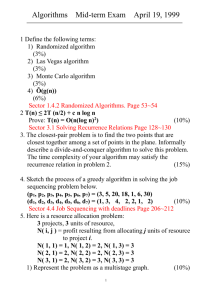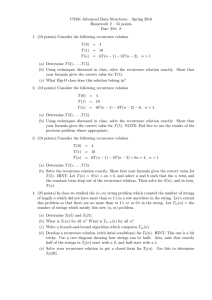Math 308 Section-Zhou, Review for Exam 2 1. 2.
advertisement
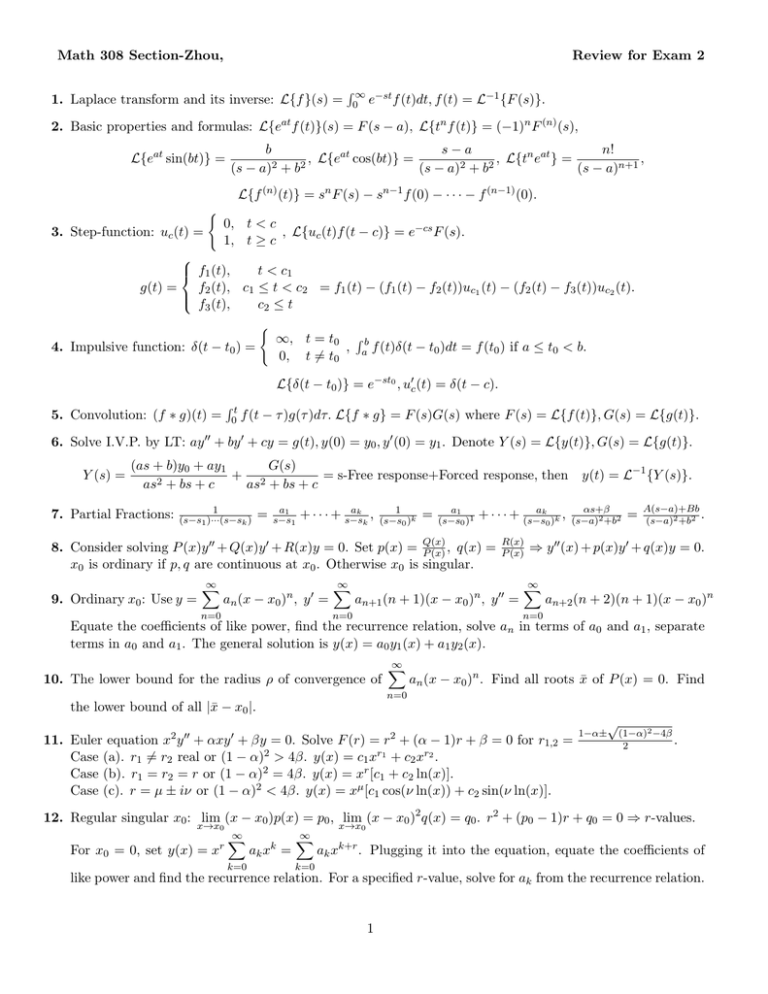
Math 308 Section-Zhou,
Review for Exam 2
1. Laplace transform and its inverse: L{f }(s) =
∫∞
0
e−st f (t)dt, f (t) = L−1 {F (s)}.
2. Basic properties and formulas: L{eat f (t)}(s) = F (s − a), L{tn f (t)} = (−1)n F (n) (s),
b
s−a
n!
, L{eat cos(bt)} =
, L{tn eat } =
,
2
2
2
2
(s − a) + b
(s − a) + b
(s − a)n+1
L{eat sin(bt)} =
{
3. Step-function: uc (t) =
L{f (n) (t)} = sn F (s) − sn−1 f (0) − · · · − f (n−1) (0).
0, t < c
, L{uc (t)f (t − c)} = e−cs F (s).
1, t ≥ c
f1 (t),
t < c1
f2 (t), c1 ≤ t < c2 = f1 (t) − (f1 (t) − f2 (t))uc1 (t) − (f2 (t) − f3 (t))uc2 (t).
g(t) =
f (t),
c2 ≤ t
3
{
4. Impulsive function: δ(t − t0 ) =
∞, t = t0 ∫ b
, a f (t)δ(t − t0 )dt = f (t0 ) if a ≤ t0 < b.
0, t =
̸ t0
L{δ(t − t0 )} = e−st0 , u′c (t) = δ(t − c).
∫t
5. Convolution: (f ∗ g)(t) =
0
f (t − τ )g(τ )dτ. L{f ∗ g} = F (s)G(s) where F (s) = L{f (t)}, G(s) = L{g(t)}.
6. Solve I.V.P. by LT: ay ′′ + by ′ + cy = g(t), y(0) = y0 , y ′ (0) = y1 . Denote Y (s) = L{y(t)}, G(s) = L{g(t)}.
Y (s) =
(as + b)y0 + ay1
G(s)
+ 2
= s-Free response+Forced response, then
2
as + bs + c
as + bs + c
7. Partial Fractions:
1
(s−s1 )···(s−sk )
=
a1
s−s1
ak
,
+ · · · + s−s
k
1
(s−s0 )k
=
a1
(s−s0 )1
ak
+ · · · + (s−s
k,
0)
8. Consider solving P (x)y ′′ + Q(x)y ′ + R(x)y = 0. Set p(x) = Q(x)
P (x) , q(x) =
x0 is ordinary if p, q are continuous at x0 . Otherwise x0 is singular.
9. Ordinary x0 : Use y =
∞
∑
an (x − x0 )n , y ′ =
n=0
∞
∑
R(x)
P (x)
an+1 (n + 1)(x − x0 )n , y ′′ =
n=0
y(t) = L−1 {Y (s)}.
αs+β
(s−a)2 +b2
=
A(s−a)+Bb
.
(s−a)2 +b2
⇒ y ′′ (x) + p(x)y ′ + q(x)y = 0.
∞
∑
an+2 (n + 2)(n + 1)(x − x0 )n
n=0
Equate the coefficients of like power, find the recurrence relation, solve an in terms of a0 and a1 , separate
terms in a0 and a1 . The general solution is y(x) = a0 y1 (x) + a1 y2 (x).
10. The lower bound for the radius ρ of convergence of
an (x − x0 )n . Find all roots x̄ of P (x) = 0. Find
n=0
the lower bound of all |x̄ − x0 |.
x2 y ′′
∞
∑
αxy ′
11. Euler equation
+
+ βy = 0. Solve F (r) = + (α − 1)r + β = 0 for r1,2 =
Case (a). r1 ̸= r2 real or (1 − α)2 > 4β. y(x) = c1 xr1 + c2 xr2 .
Case (b). r1 = r2 = r or (1 − α)2 = 4β. y(x) = xr [c1 + c2 ln(x)].
Case (c). r = µ ± iν or (1 − α)2 < 4β. y(x) = xµ [c1 cos(ν ln(x)) + c2 sin(ν ln(x)].
r2
1−α±
√
(1−α)2 −4β
.
2
12. Regular singular x0 : lim (x − x0 )p(x) = p0 , lim (x − x0 )2 q(x) = q0 . r2 + (p0 − 1)r + q0 = 0 ⇒ r-values.
x→x0
For x0 = 0, set y(x) = xr
∞
∑
k=0
ak xk =
∞
∑
x→x0
ak xk+r . Plugging it into the equation, equate the coefficients of
k=0
like power and find the recurrence relation. For a specified r-value, solve for ak from the recurrence relation.
1


